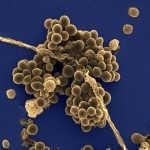Link to Pubmed [PMID] – 25358409
Nanoscale 2014 Dec;6(24):14820-7
The surface of many bacterial pathogens is covered with polysaccharides that play important roles in mediating pathogen-host interactions. In Streptococcus agalactiae, the capsular polysaccharide (CPS) is recognized as a major virulence factor while the group B carbohydrate (GBC) is crucial for peptidoglycan biosynthesis and cell division. Despite the important roles of CPS and GBC, there is little information available on the molecular organization of these glycopolymers on the cell surface. Here, we use atomic force microscopy (AFM) and transmission electron microscopy (TEM) to analyze the nanoscale distribution of CPS and GBC in wild-type (WT) and mutant strains of S. agalactiae. TEM analyses reveal that in WT bacteria, peptidoglycan is covered with a very thin (few nm) layer of GBC (the “pellicle”) overlaid by a 15-45 nm thick layer of CPS (the “capsule”). AFM-based single-molecule mapping with specific antibody probes shows that CPS is exposed on WT cells, while it is hardly detected on mutant cells impaired in CPS production (ΔcpsE mutant). By contrast, both TEM and AFM show that CPS is over-expressed in mutant cells altered in GBC expression (ΔgbcO mutant), indicating that the production of the two surface glycopolymers is coordinated in WT cells. In addition, AFM topographic imaging and molecular mapping with specific lectin probes demonstrate that removal of CPS (ΔcpsE), but not of GBC (ΔgbcO), leads to the exposure of peptidoglycan, organized into 25 nm wide bands running parallel to the septum. These results indicate that CPS forms a homogeneous barrier protecting the underlying peptidoglycan from environmental exposure, while the presence of GBC does not prevent peptidoglycan detection. This work shows that single-molecule AFM, combined with high-resolution TEM, represents a powerful platform for analysing the molecular arrangement of the cell wall polymers of bacterial pathogens.


